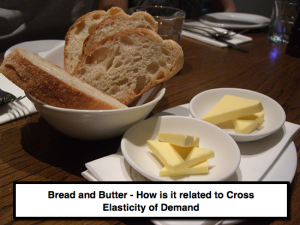*Note: This topic is for H2 Economics only.
Similar to the previous two topics, Price Elasticity of Demand “PED” and Income Elasticity of Demand “YED”, Cross Elasticity of Demand “XED” illustrates to us by how much, for example, the quantity of bread will change when there is a change in price of butter. In XED, we are concern about finding the relationship of a pair of goods, be it:
- Bread and Butter;
- Wine and Beer;
- Egg and Car.
First of all, there are three important relationships of these paired goods. They are:
- Complementary goods – Goods that are regularly consumed TOGETHER. Bread & Butter / Car & Petrol are good examples of complementary goods.
- Substitute goods – Goods that can substitute EACH OTHER. Wine & Beer / DVD & Movie Tickets are good examples of substitutes.
- Unrelated goods – Goods that have no reason to be related to each other. Egg & Car is a combination.
So why should we learn about XED? Aren’t PED and YED sufficient? We want to learn about XED because we are interested to find out the:
- relationship of the pair of goods – whether they are complementary, substitute or unrelated good;
- impact on each other – how will the price change of 1 good impact on the quantity of the other good.
Similar to YED, XED can take into three different kind of magnitudes too:
- XED > 0 – an increase in price of good A will lead to increase in quantity demanded for good B (goes in same direction, that’s why its positive). This is a substitution effect as people are substituting from good A to Good B [Substitute Goods];
- XED = 0 – an increase in price of good A will lead no change in quantity demanded of good B. Think, would changes in car price have any impact on quantity demanded of eggs [Unrelated Goods]?
- XED < 0 – an increase in price of good A will lead to a fall in quantity demanded for good B (goes in opposite direction, that’s why its negative). If price of car fuel increase, would you still buy a car [Complementary goods]?
Apple iPhone marketing managers (who have learnt economics) will be able to apply this concept to find how Samsung Note is “related” to them – by simply lowering price of iPhones, they can “steal” the market share of Samsung Note. At such, they are substitute goods.
However, Apple Marketing managers may not have access to how much market share they are able to steal from Samsung as they are direct rivals and they do not have access to sensitive datas only accessible to Samsung Note producers. At such, they are not able to make perfect pricing decision.
In our regular economics lessons, we often use real life examples like this to illustrate and break down economics concepts like Cross Elasticity of Demand and make learning easy! Find out more about our interesting regular class!
[aio_button align=”center” animation=”none” color=”blue” size=”small” icon=”none” text=”JC Econs & Schedule” relationship=”dofollow” url=”https://aceyourecons.sg/jc-economics/”]
[aio_button align=”center” animation=”none” color=”red” size=”small” icon=”none” text=”Poly Econs” relationship=”dofollow” url=”https://aceyourecons.sg/poly-economics/”]
[aio_button align=”center” animation=”none” color=”green” size=”small” icon=”none” text=”Related Topic – Price Elasticity of Demand” relationship=”dofollow” url=”https://aceyourecons.sg/topical-summary-price-elasticity-of-demand/”]
[aio_button align=”center” animation=”none” color=”yellow” size=”small” icon=”none” text=”Related Topic – Income Elasticity of Demand” relationship=”dofollow” url=”https://aceyourecons.sg/topical-summary-income-elasticity-of-demand/”]
[aio_button align=”center” animation=”none” color=”orange” size=”small” icon=”none” text=”Back to Home” relationship=”dofollow” url=”https://aceyourecons.sg/”]


